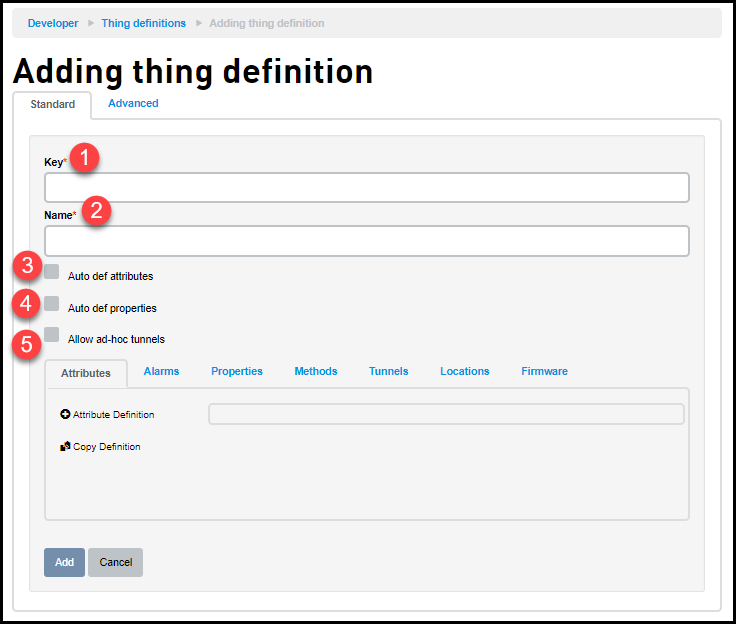deviceWISE Cloud Part 2 - Creating a Thing definition
If you already have a Thing definition, then you can skip this part and go to deviceWISE CloudPart 3 - Creating an Application token
The Thing definition is analogous to a class in object oriented programming. A class is a template for defining objects. It specifies the names and types of variables that exists in an object, as well as "methods"--procedures for operating on those variables. Similarly in the Management Portal a Thing definition contains the attributes, functions and properties that exists in a Thing.
A thing definition models the attributes, alarms, properties, methods, tunnels, presentation information, and other characteristics of a particular type of item that is a portion of your IoT solution. To define a thing definition, do the following:
- From the
Developer main screen in
the
THINGS group, click
Thing
definitions.
The Thing definitions screen appears. - Click the
New thing
definition button

The Adding thing definition page appears. - Enter the following fields to create a new Thing
definition:

S.No. Field Description 1 Key The key for the thing definition. For more information on key formats and limitations, see Field Formats and Limitations 2 Name The name of the thing definition 3 Auto def attributes Allows the thing to auto define its attributes 4 Auto def properties Allows the thing to auto define its properties 5 Allow ad-hoc tunnels Allows the thing to connect to ad-hoc tunnels - Define the characteristics of the thing
definition using the following characteristic
tabs
ParametersDescription
Attributes Attributes are simple key value string pairs for storing meta-data for a thing. For example, The VIN on a car, a serial number of a piece of equipment, a customer name, and so on. Alarms Alarms are implemented as a state machine, where the events are defined as alarm states. For example: For a thing that represents a tank, defining an alarm for low level. For a thing that represents an engine, defining an alarm for whether the engine is on or off.
Things can have multiple alarms. Each alarm can have multiple states. Alarms are graphed since they have a state and timestamp component.Properties Properties are used to store historical data for a thing, at a specific timestamp. The data could be anything, it is stored as a floating point value with the "real" value, as well as aggregations at 1 hour and 1 day for averages, minimum, and maximum values.
Properties are graphed since they have a value and timestamp component.Methods Methods define the interface to functions that are implemented in a gateway trigger (using TR50 Method trigger event type) or are implemented in an application. The "calling" of a thing's method can be from a gateway trigger, from an application, from the thing's page in the Management Portal, or from a cloud trigger within the IoT Portal. Tunnels Tunnels support a client application to connect to a server application on a gateway, using the IoT Portal as the communication mechanism. Locations Locations are used to define how things that have this thing definition respond to location information. Firmware Firmware tab is used to define the Firmware. - Click Add.